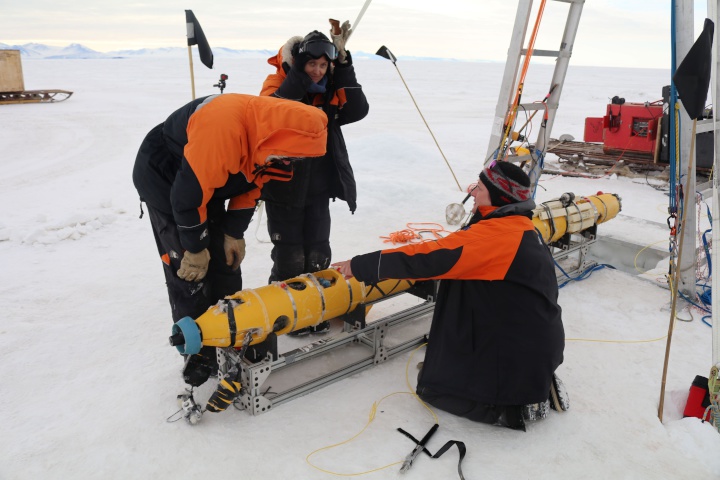The Hippest Supercool Science On Earth
A team of Antarctic scientists is breaking new ground – or ice at least – in scientific research.

Inspecting frazil on Icefin. By Andy Mullen
They’ve designed a cutting-edge device to measure supercooled ocean water under sea ice.
The Kiwi-led project, funded by the Marsden Fund, is collaborating with Norwegian and US scientists to build a High Precision Supercooling Measurement Instrument (HiPSMI) that can be sent below the ice on the Icefin (a small, remotely-operated submersible robot) to precisely measure exactly how cold the water gets.
Dr Inga Smith, from the University of Otago, says sea ice usually freezes at -1.9 degrees Celsius. But that’s not the case when fresh water flows from beneath an ice shelf and mixes with the salty sea water.
“Then it becomes what’s called supercooled, so it’s still liquid but actually below the freezing point. It then snap freezes into these crystals called frazil, they attach to the sea ice and form platelet ice. That means the sea ice in this area is thicker and grows faster than it would otherwise, certainly thicker and faster than you would expect in the Arctic, for example, in a similar location.
“We’re really pushing the edge of polar engineering here, operating in these really cold temperatures and making high-precision measurements of that supercooling,” she says.
Maren Richter, a PhD student from University of Otago, says oceans under ice shelves are a large black spot in our knowledge.
“We know more about the dark side of the moon than we know about what’s going on underneath the Ross Ice Shelf!
“These measurements help to inform understanding of how the system that is the ocean, the ice and the atmosphere works together, and how that all interconnects. These are all calculated by large scale models and the more accurate we can make these models, even on really small scales like this, the more accurate it will be on larger scales like informing weather in the future in New Zealand,” she says.
To test the HiPSMI in Antarctica for the first time, the team worked out of a containerised ice camp on McMurdo Sound. Sarah Williamson, Antarctica New Zealand Chief Executive, says the containerised camp, owned by NIWA, was key for the team’s success.
“They managed to collect oceanographic and sea ice data for 17 of the 20 days at the ice camp, and HiPSMI data on eight of those days. It’s always satisfying when we can support this world-leading science so successfully in Antarctica, particularly when it has such important ramifications for the rest of the planet,” she says.


 NIWA: Flooding From Underneath - New Tool Reveals Shallow Groundwater Elevations
NIWA: Flooding From Underneath - New Tool Reveals Shallow Groundwater Elevations Commerce Commission: Commission Concludes Auckland Airport Over-charging By $190 Million
Commerce Commission: Commission Concludes Auckland Airport Over-charging By $190 Million The Future Is Rail: Ferry Decision - Common Sense Prevails
The Future Is Rail: Ferry Decision - Common Sense Prevails Aotearoa Food Rescue Alliance: Grocery Market Reform Must Include Mandatory Food Rescue Partnerships
Aotearoa Food Rescue Alliance: Grocery Market Reform Must Include Mandatory Food Rescue Partnerships Hugh Grant: Zero Trust Security - A Buzzword Or The Ultimate Protection?
Hugh Grant: Zero Trust Security - A Buzzword Or The Ultimate Protection? Bill Bennett: Comcom revisits fibre rules as competition intensifies
Bill Bennett: Comcom revisits fibre rules as competition intensifies



